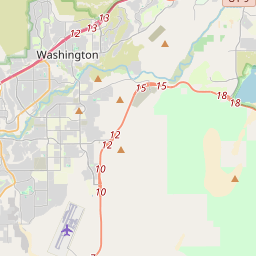Winter Home of Brigham Young
Historical marker location:
67 West 200 North, St. George, Utah
( Marker is on West 200 North, on the right when traveling east.)
Marker installed: 1947







© OpenStreetMap contributors
Loading...
Searching for other points of interest within 3 miles of this location.The Utah State Fair, held annually in Salt Lake City, is one of the oldest state fairs in the country, dating back to 1856.
About Washington County
Washington County Timeline
Washington County, Utah has a rich and diverse history that stretches back thousands of years. The area was originally home to the Southern Paiute Native American tribe, who thrived here for centuries before the arrival of European settlers. Spanish explorers were the first Europeans to venture into the region in the 1770s, although they did not establish a permanent presence.
The mid-1800s saw the arrival of Mormon pioneers, led by Brigham Young, who settled in what is now known as St. George, the county seat and largest city of Washington County. These settlers sought refuge from persecution and established farming communities, taking advantage of the fertile soil and mild climate. They built irrigation systems known as "reclamation projects" to bring water to the arid desert, making agriculture possible in the region.
Washington County became a hub for agricultural production in the late 19th and early 20th centuries, with orchards, vineyards, and dairy farms dotting the landscape. The construction of the St. George Temple, one of the oldest continuously operating LDS (Latter-Day Saint) temples, added to the area's significance as a religious and cultural center.
In recent years, Washington County has experienced significant population growth thanks to its natural beauty, recreational opportunities, and thriving economy. The region has become a popular retirement destination and a hub for outdoor activities such as hiking, biking, and off-roading. Today, Washington County is a vibrant and dynamic community that embraces its history while continuing to evolve and adapt to the changing times.
The mid-1800s saw the arrival of Mormon pioneers, led by Brigham Young, who settled in what is now known as St. George, the county seat and largest city of Washington County. These settlers sought refuge from persecution and established farming communities, taking advantage of the fertile soil and mild climate. They built irrigation systems known as "reclamation projects" to bring water to the arid desert, making agriculture possible in the region.
Washington County became a hub for agricultural production in the late 19th and early 20th centuries, with orchards, vineyards, and dairy farms dotting the landscape. The construction of the St. George Temple, one of the oldest continuously operating LDS (Latter-Day Saint) temples, added to the area's significance as a religious and cultural center.
In recent years, Washington County has experienced significant population growth thanks to its natural beauty, recreational opportunities, and thriving economy. The region has become a popular retirement destination and a hub for outdoor activities such as hiking, biking, and off-roading. Today, Washington County is a vibrant and dynamic community that embraces its history while continuing to evolve and adapt to the changing times.
Washington County Timeline
This timeline provides a condensed summary of the historical journey of Washington County, Utah.
- 1776-1777: It is believed that Spanish explorers, Francisco Garcés and Silvestre Vélez de Escalante, were the first non-Native Americans to enter what is now Washington County.
- 1847: Mormon pioneers led by Brigham Young arrived in the Salt Lake Valley and began exploring areas for settlement.
- 1852: The first Mormon settlers arrived in what is now Washington County and established the community of Santa Clara.
- 1854: St. George was settled and became the county seat.
- 1861: Washington County was officially created by the Utah Territorial Legislature.
- 1871: The St. George Temple, the first temple completed by The Church of Jesus Christ of Latter-day Saints in Utah, was dedicated.
- 1882: The area's rich iron deposits led to the establishment of the Silver Reef mining district, which attracted miners and entrepreneurs.
- 1897: The United Order communal system was abolished in Washington County, leading to a shift towards individual land ownership and economic development.
- 1923: Zion National Park was established, showcasing the region's stunning natural beauty.
- 1935: The completion of the Hoover Dam brought economic opportunities to the county.
- 2005: The Washington County School District became the largest district in Utah, highlighting the county's population growth and development.